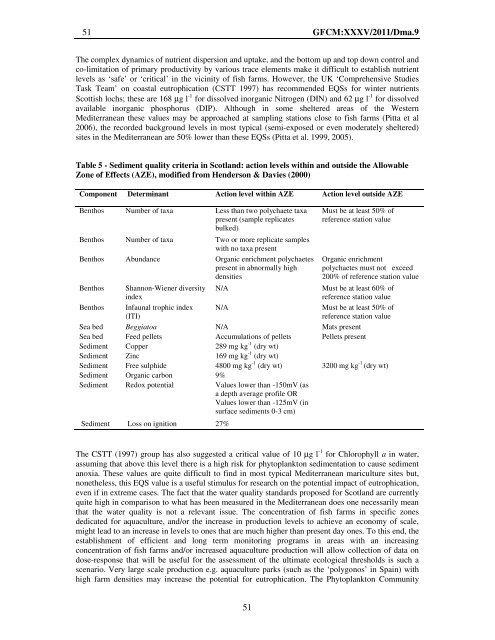Site selection and carrying capacity in Mediterranean ... - FAO Sipam
Site selection and carrying capacity in Mediterranean ... - FAO Sipam
Site selection and carrying capacity in Mediterranean ... - FAO Sipam
You also want an ePaper? Increase the reach of your titles
YUMPU automatically turns print PDFs into web optimized ePapers that Google loves.
51 GFCM:XXXV/2011/Dma.9<br />
The complex dynamics of nutrient dispersion <strong>and</strong> uptake, <strong>and</strong> the bottom up <strong>and</strong> top down control <strong>and</strong><br />
co-limitation of primary productivity by various trace elements make it difficult to establish nutrient<br />
levels as ‘safe’ or ‘critical’ <strong>in</strong> the vic<strong>in</strong>ity of fish farms. However, the UK ‘Comprehensive Studies<br />
Task Team’ on coastal eutrophication (CSTT 1997) has recommended EQSs for w<strong>in</strong>ter nutrients<br />
Scottish lochs; these are 168 µg l -1 for dissolved <strong>in</strong>organic Nitrogen (DIN) <strong>and</strong> 62 µg l -1 for dissolved<br />
available <strong>in</strong>organic phosphorus (DIP). Although <strong>in</strong> some sheltered areas of the Western<br />
<strong>Mediterranean</strong> these values may be approached at sampl<strong>in</strong>g stations close to fish farms (Pitta et al<br />
2006), the recorded background levels <strong>in</strong> most typical (semi-exposed or even moderately sheltered)<br />
sites <strong>in</strong> the <strong>Mediterranean</strong> are 50% lower than these EQSs (Pitta et al. 1999, 2005).<br />
Table 5 - Sediment quality criteria <strong>in</strong> Scotl<strong>and</strong>: action levels with<strong>in</strong> <strong>and</strong> outside the Allowable<br />
Zone of Effects (AZE), modified from Henderson & Davies (2000)<br />
Component Determ<strong>in</strong>ant Action level with<strong>in</strong> AZE Action level outside AZE<br />
Benthos Number of taxa Less than two polychaete taxa<br />
present (sample replicates<br />
bulked)<br />
Benthos Number of taxa Two or more replicate samples<br />
with no taxa present<br />
Benthos Abundance Organic enrichment polychaetes<br />
present <strong>in</strong> abnormally high<br />
densities<br />
Benthos Shannon-Wiener diversity<br />
<strong>in</strong>dex<br />
Benthos Infaunal trophic <strong>in</strong>dex<br />
(ITI)<br />
51<br />
Must be at least 50% of<br />
reference station value<br />
Organic enrichment<br />
polychaetes must not exceed<br />
200% of reference station value<br />
N/A Must be at least 60% of<br />
reference station value<br />
N/A Must be at least 50% of<br />
reference station value<br />
Sea bed Beggiatoa N/A Mats present<br />
Sea bed Feed pellets Accumulations of pellets Pellets present<br />
Sediment Copper 289 mg kg -1 (dry wt)<br />
Sediment Z<strong>in</strong>c 169 mg kg -1 (dry wt)<br />
Sediment Free sulphide 4800 mg kg -1 (dry wt) 3200 mg kg -1 (dry wt)<br />
Sediment Organic carbon 9%<br />
Sediment Redox potential Values lower than -150mV (as<br />
a depth average profile OR<br />
Values lower than -125mV (<strong>in</strong><br />
surface sediments 0-3 cm)<br />
Sediment Loss on ignition 27%<br />
The CSTT (1997) group has also suggested a critical value of 10 µg l -1 for Chlorophyll a <strong>in</strong> water,<br />
assum<strong>in</strong>g that above this level there is a high risk for phytoplankton sedimentation to cause sediment<br />
anoxia. These values are quite difficult to f<strong>in</strong>d <strong>in</strong> most typical <strong>Mediterranean</strong> mariculture sites but,<br />
nonetheless, this EQS value is a useful stimulus for research on the potential impact of eutrophication,<br />
even if <strong>in</strong> extreme cases. The fact that the water quality st<strong>and</strong>ards proposed for Scotl<strong>and</strong> are currently<br />
quite high <strong>in</strong> comparison to what has been measured <strong>in</strong> the <strong>Mediterranean</strong> does one necessarily mean<br />
that the water quality is not a relevant issue. The concentration of fish farms <strong>in</strong> specific zones<br />
dedicated for aquaculture, <strong>and</strong>/or the <strong>in</strong>crease <strong>in</strong> production levels to achieve an economy of scale,<br />
might lead to an <strong>in</strong>crease <strong>in</strong> levels to ones that are much higher than present day ones. To this end, the<br />
establishment of efficient <strong>and</strong> long term monitor<strong>in</strong>g programs <strong>in</strong> areas with an <strong>in</strong>creas<strong>in</strong>g<br />
concentration of fish farms <strong>and</strong>/or <strong>in</strong>creased aquaculture production will allow collection of data on<br />
dose-response that will be useful for the assessment of the ultimate ecological thresholds is such a<br />
scenario. Very large scale production e.g. aquaculture parks (such as the ‘polygonos’ <strong>in</strong> Spa<strong>in</strong>) with<br />
high farm densities may <strong>in</strong>crease the potential for eutrophication. The Phytoplankton Community
















